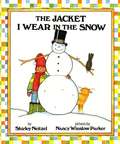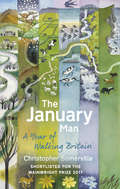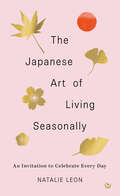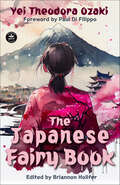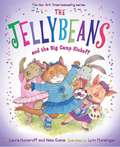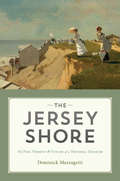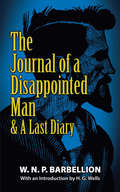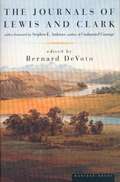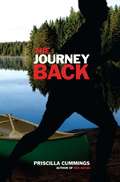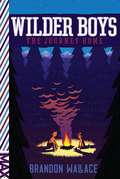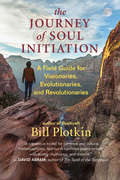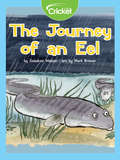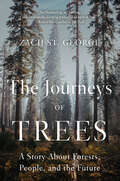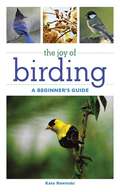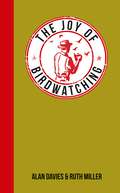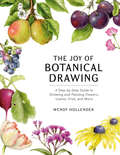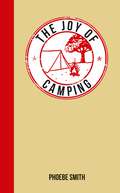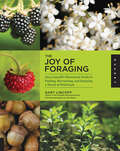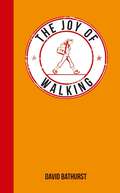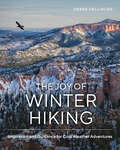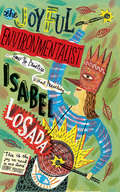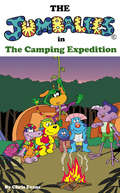- Table View
- List View
The Jacket I Wear In The Snow
by Shirley Neitzel Amy CohrRhyme follows rhyme as layer after layer of winter clothing ("bunchy and hot, wrinkled a lot, stiff in the knee, and too big for me!") is first put on and then taken off to the relief of the child bundled inside. The Jacket I Wear in the Snow especially fun for prereaders and new readers.
The Jaguar Hunter
by Lucius ShepardFourteen short stories, including a novella. From a war of the future and wind spirits to a woman's end of life, this is filled with diverse plots.
The January Man: A Year of Walking Britain
by Christopher Somerville'Evocatively written and charming' - Countryfile'The January Man is a book that makes you want to pull on your boots, grab a map and get out there' - Country LifeThe January Man is the story of a year of walks that was inspired by a song, Dave Goulder's 'The January Man'. Month by month, season by season and region by region, Christopher Somerville walks the British Isles, following routes that continually bring his father to mind. As he travels the country - from the winter floodlands of the River Severn to the lambing pastures of Nidderdale, the towering seabird cliffs on the Shetland Isle of Foula in June and the ancient oaks of Sherwood Forest in autumn - he describes the history, wildlife, landscapes and people he encounters, down back lanes and old paths, in rain and fair weather.This exquisitely written account of the British countryside not only inspires us to don our boots and explore the 140,000 miles of footpaths across the British Isles, but also illustrates how, on long-distance walks, we can come to an understanding of ourselves and our fellow walkers. Over the hills and along the byways, Christopher Somerville examines what moulded the men of his father's generation - so reticent about their wartime experiences, so self-effacing, upright and dutiful - as he searches for 'the man inside the man' that his own father really was.
The Japanese Art of Living Seasonally: An invitation to celebrate every day
by Natalie LeonWritten by Japanologist Natalie Leon, this beautiful guide unlocks the secrets of Japan's seasonal culture to help you relish the seasons wherever you are.Relish every day with the secrets of Japan&’s seasonal cultureIn traditional Japanese culture, people eat, sleep and wear the seasons, from kimono motifs to petal-shaped sweets, and festivals dedicated to nature&’s spectacular displays. This mindful celebration of nature leads to a deep awareness of the seasons, called kisetsukan.This book reveals the hidden depths of kisetsukan, and how its concepts can transform your life. Discover: Shun, eating what is fresh and bountiful. Preserve edible flowers to use in homemade sweets, or taste the spring with &“seven herb&” porridge.Mottainai, zero-waste living. Learn about boro boro, visible mending that honours the history of a cherished garment, or wrap gifts in sustainable, seasonal fabrics.Kadō, the Way of Flowers. Learn the rules of ikebana and arrange flowers according to the seasons, or throw a cherry blossom-viewing party.Momijigari, the ritual of leaf hunting. Explore local nature with &“forest bathing&”, or learn simple ways to bring the outside inside. This treasure trove of folktales, recipes and activities is an invitation to celebrate each day, for increased creativity, harmony and happiness.
The Japanese Fairy Book
by Yei Theodora OzakiThe original classic collection where a biracial Japanese woman made her adopted homeland’s fairy tales her own. Yei Theodora Ozaki had a 19th century British upbringing, but embraced her Eastern heritage once she moved to Japan at sixteen. Refusing to marry, she made her own way and fell in love with the folklore of her new home. The Japanese Fairy Book became the first of many collections she adapted to bridge her two cultures and share these treasured stories with the English-speaking world. Marvel at the Dragon King and his palace under the sea. Awe over Princess Moonlight outwitting every would-be suitor to stay with her elderly foster parents. Cheer on Momotaro, the boy born from a peach who fights ogres with his trusty animal companions. Explore the age of giants and gods with wise Empress Jokwa as she defends her kingdom from a tyrannical wizard. Whimsical and tragic, epic and frightening, Ozaki’s translations of cunning creatures, brave samurai, royal dramas, and folk adventures from a bygone era will enchant readers of any age.
The Jellybeans and the Big Camp Kickoff
by Laura Joffe Numeroff Nate EvansThe Jellybeans are off to summer camp to enjoy ghost stories around the campfire, roasting marshmallows, and swimming in the lake. Each girl finds her own favorite activity: Emily goes to the dance studio, Bitsy does arts and crafts, and Anna reads about nature. But Nicole can't find anything that's just right for her. So she decides to start a soccer team and teach her friends her favorite game. Will the Jellybeans be able to win the big match against a neighboring camp? Once again, the girls use their different strengths and talents to work together and have the best summer ever. This third book in the successfulNew York Timesbestselling series shows that, whether readers are girly girls, bookworms, artists, or tomboys, there is a Jellybean for everyone.
The Jersey Shore: The Past, Present & Future of a National Treasure
by Dominick MazzagettiIn The Jersey Shore, Dominick Mazzagetti provides a modern re-telling of the history, culture, and landscapes of this famous region, from the 1600s to the present. The Shore, from Sandy Hook to Cape May, became a national resort in the late 1800s and contributes enormously to New Jersey’s economy today. The devastation of Hurricane Sandy in 2012 underscored the area’s central place in the state’s identity and the rebuilding efforts after the storm restored its economic health. Divided into chronological and thematic sections, this book will attract general readers interested in the history of the Shore: how it appeared to early European explorers; how the earliest settlers came to the beaches for the whaling trade; the first attractions for tourists in the nineteenth century; and how the coming of railroads, and ultimately automobiles, transformed the Shore into a major vacation destination over a century later. Mazzagetti also explores how the impact of changing national mores on development, race relations, and the environment, impacted the Shore in recent decades and will into the future. Ultimately, this book is an enthusiastic and comprehensive portrait by a native son, whose passion for the region is shared by millions of beachgoers throughout the Northeast.
The Journal of a Disappointed Man: & A Last Diary
by W.N.P. BarbellionPublished shortly before the author's death in 1919, The Journal of a Disappointed Man presents a remarkable memoir that addresses struggles with poverty, inadequate education, and the creeping paralysis of multiple sclerosis. Yet author W. N. P. Barbellion manages to write with uplifting eloquence and passion of his love for family, natural history, music, and literature. Told with a thoroughly modern voice, the unjustly overlooked Journal is reprinted here with its posthumous successor, A Last Diary. This edition features a thoughtful Introduction by H. G. Wells, who writes of the book's "exquisite beauty." W. N. P. Barbellion (1889–1919), whose real name was Bruce Frederick Cummings, was a naturalist who worked in the Entomology Department of London's Natural History Museum. Upon attempting to enlist in the British Army during World War I, he was diagnosed with multiple sclerosis. The discovery of his disease intensified the tenor of his journal-keeping, and his frank and articulate reflections on coping with a fatal illness remain a powerful testament to his life and struggles.
The Journals of Lewis and Clark
by Bernard Devoto Meriwether LewisHere is your chance to travel with the great explorers Captains Meriwether Lewis & William Clark. Live experiences with them through their own words (misspellings and all) written with quill pens.
The Journey Back
by Priscilla CummingsEscaped and on the run, can Digger find redemption? His bold escape from a juvenile detention facility nearly kills him, but soon an angry fourteen-year-old Digger is on the run, hijacking a tractor trailer, "borrowing" a bicycle, and stealing a canoe. When injuries stop him, Digger hides at a riverside campground, where he befriends a young boy and a girl his own age. New friends, a job caring for rescued horses, and risking his life to save another make Digger realize that the journey back is not just about getting home, it's about discovering what he's really running from, and how to come to terms with his troubled past.
The Journey Home (Wilder Boys)
by Brandon WallaceTwo brothers must rely on all their wilderness skills to survive their journey home after reuniting with their father and living off the grid in the second adventure of the Wilder Boys series.At the start of the summer, Jake and Taylor Wilder set out on the adventure of a lifetime. After seeing their mother loaded into an ambulance because of Bull, her terrifying boyfriend, the boys know they are no longer safe. So they go in search of their father, who has been living off the grid in Wyoming. After jumping trains, hitching a ride with a truck driver, and hiding in the luggage compartment of a tour bus, the boys finally find him in Grand Teton National Park. Just as the boys are getting used to their father's lifestyle--and his "my way is the only way" attitude--they learn that their mother is still alive. But if the brothers don't give back the money they took from Bull last year, she could be taken away from them...for good. Convinced that their father isn't going to help, the Wilder boys set out on their own again. It's a long way from Wyoming to Pittsburgh, and with winter approaching there will be new challenges. But they have to get back. Will the brothers be able to make it back to their mother before it's too late?
The Journey of Soul Initiation: A Field Guide for Visionaries, Evolutionaries, and Revolutionaries
by Bill PlotkinSoul initiation is an essential spiritual adventure that most of the world has forgotten — or not yet discovered. Here, visionary ecopsychologist Bill Plotkin maps this journey, one that has not been previously illuminated in the contemporary Western world and yet is vital for the future of our species and our planet. Based on the experiences of thousands of people, this book provides phase-by-phase guidance for the descent to soul — the dissolution of current identity; the encounter with the mythopoetic mysteries of soul; and the metamorphosis of the ego into a cocreator of life-enhancing culture. Plotkin illustrates each phase of this riveting and sometimes hazardous odyssey with fascinating stories from many people, including those he has guided. Throughout he weaves an in-depth exploration of Carl Jung&’s Red Book — and an innovative framework for understanding it.
The Journey of an Eel
by Galadriel WatsonThe freshwater eel is a fish that makes two remarkable journeys, one at the beginning of its life, and another at the end. It is born in the ocean, lives its adult life in a freshwater stream, then returns to the ocean.
The Journeys of Trees: A Story About Forests, People, And The Future
by Zach St. GeorgeAn urgent and illuminating portrait of forest migration, and of the people studying the forests of the past, protecting the forests of the present, and planting the forests of the future. Forests are restless. Any time a tree dies or a new one sprouts, the forest that includes it has shifted. When new trees sprout in the same direction, the whole forest begins to migrate, sometimes at astonishing rates. Today, however, an array of obstacles—humans felling trees by the billions, invasive pests transported through global trade—threaten to overwhelm these vital movements. Worst of all, the climate is changing faster than ever before, and forests are struggling to keep up. A deft blend of science reporting and travel writing, The Journeys of Trees explores the evolving movements of forests by focusing on five trees: giant sequoia, ash, black spruce, Florida torreya, and Monterey pine. Journalist Zach St. George visits these trees in forests across continents, finding sequoias losing their needles in California, fossil records showing the paths of ancient forests in Alaska, domesticated pines in New Zealand, and tender new sprouts of blight-resistant American chestnuts in New Hampshire. Everywhere he goes, St. George meets lively people on conservation’s front lines, from an ecologist studying droughts to an evolutionary evangelist with plans to save a dying species. He treks through the woods with activists, biologists, and foresters, each with their own role to play in the fight for the uncertain future of our environment. An eye-opening investigation into forest migration past and present, The Journeys of Trees examines how we can all help our trees, and our planet, survive and thrive.
The Joy of Birding: A Beginner's Guide (Joy of Series)
by Kate RowinskiMore than 50 million birders can't be wrong. No matter where you live, you have the joy of hearing and seeing birds. This easy-to-use, full-color guide will provide you with the answers. Here you'll learn how to identify different bird species by observing their body-parts, understand birds' behavior and habits, get to know the birds around the home or a vacation spot, attract and make a good home for these new feathered friends, and much more! Designed especially for the home birdwatcher, but with information on destination vacations, this book teaches, "If you're prepared to see them, they will come!"
The Joy of Birdwatching: For Those Who Love Seeing Birds in the Wild
by Alan Davies Ruth MillerThis pocket-sized miscellany, packed with fascinating facts, handy hints and captivating stories and quotes from the world of birds, is perfect for anyone who knows the incomparable joy of birdwatching.
The Joy of Birdwatching: For Those Who Love Seeing Birds in the Wild
by Alan Davies Ruth MillerThis pocket-sized miscellany, packed with fascinating facts, handy hints and captivating stories and quotes from the world of birds, is perfect for anyone who knows the incomparable joy of birdwatching.
The Joy of Botanical Drawing: A Step-by-Step Guide to Drawing and Painting Flowers, Leaves, Fruit, and More
by Wendy HollenderA gorgeous, easy-to-follow, and inspiring guide to stunningly realistic botanical drawing that covers everything you need to draw our natural world.Achieve amazingly realistic and vibrant botanical illustrations, from flowers so dazzling you feel as if you might be able to smell them, to tomatoes that look as if they've just been picked from the garden. Wendy Hollender is known for her vivid, detailed, and inspiring illustrations and in The Joy of Botanical Drawing, she helps you take your art to the next level by sharing her perfected techniques through short lessons that start simple, then build on the basics with easy-to-use and clear step-by-step illustrations. Using colored pencils and watercolor pencils, Hollender shows you how to accomplish scientifically accurate botanical portraits of a spiraling pine cone, a spiky chestnut, a fuchsia-tined radish, a graceful morning glory, and many more.From colorful leaves to delicate petals to textured bark and slender stems, The Joy of Botanical Drawing will give you the skills to complete lifelike drawings while also enjoying nature and the mindfulness of a regular drawing practice.
The Joy of Camping: For Those Who Love the Great Outdoors (The\joy Of Ser.)
by Phoebe SmithThis pocket-sized miscellany, packed with tips on equipment, food, surviving bad weather and finding the right campsite, and with facts and stories from the world of camping, is perfect for anyone who knows the incomparable joy and adventure of pitching their tent under an open sky.
The Joy of Camping: For Those Who Love the Great Outdoors (The\joy Of Ser.)
by Phoebe SmithThis pocket-sized miscellany, packed with tips on equipment, food, surviving bad weather and finding the right campsite, and with facts and stories from the world of camping, is perfect for anyone who knows the incomparable joy and adventure of pitching their tent under an open sky.
The Joy of Foraging: Gary Lincolff's Illustrated Guide to Finding, Harvesting, and Enjoying a World of Wild Food
by Gary LincoffDiscover the edible riches in your backyard, local parks, woods, and even roadside with tips from the author of The Complete Mushroom Hunter.In The Joy of Foraging, Gary Lincoff shows you how to find fiddlehead ferns, rose hips, beach plums, bee balm, and more, whether you are foraging in the urban jungle or the wild, wild woods. You will also learn about fellow foragers—experts, folk healers, hobbyists, or novices like you—who collect wild things and are learning new things to do with them every day. Along with a world of edible wild plants—wherever you live, any season, any climate—you’ll find essential tips on where to look for native plants, and how to know without a doubt the difference between edibles and toxic look-alikes. There are even ideas and recipes for preparing and preserving the wild harvest year-round—all with full-color photography. Let Gary take you on the ultimate tour of our edible wild kingdom!“Gary Lincoff’s book provides a good jumping-off place for those who would like to foster an appreciation for the mostly unlooked-for abundance that surrounds people wherever they are, and an ability to find hidden sustenance in everyday places.” —Englewood Review of Books
The Joy of Walking (The\joy Of Ser.)
by David BathurstThis pocket-sized miscellany, packed with fascinating facts, handy hints and captivating stories and quotes from the world of walking, is perfect for anyone who knows the incomparable joy and freedom of lacing up your hiking boots and heading for the hills.
The Joy of Winter Hiking: Inspiration and Guidance for Cold Weather Adventures
by Derek DellingerFrom the author of America’s Best Day Hikes, gorgeous photos and essential tips give you reason to enjoy the season! Your daily dose of nature doesn’t have to retreat with the warm weather. The Joy of Winter Hiking is your ultimate guide to getting outdoors in the most underrated season. In fact, author Derek Dellinger believes you should be seeking outdoor adventure in colder months, not just in spite of snow and cloudy days, but because of these factors! From unmatched snow-capped views to the mental and physical health benefits of nature to precious wildlife sightings, the winter holds endless hiking opportunities. Alongside stunning winter photography, Derek prepares readers to venture safely and securely into nature. There’s advice on the gear you need to get going, the wildlife you might expect to find, understanding weather risks, and even the how-tos of cold-weather camping. Made for the winter sportsman, tree hugger, and avid hiker alike, this book is a thorough guide and breathtaking showcase of what’s awaiting you on the trail.
The Joyful Environmentalist: How to Practise without Preaching
by Isabel LosadaThe feel-good book of the year for everyone who loves our planet and is looking for solutions. Fast, funny and inspiring, too. Finally! A book about saving our planet that is fast, funny and inspiring too. Written in short chapters for busy people, Isabel doesn't bother with an examination of the problem but gets right on with the solutions. Her aim: to look for every single way we can take care of the planet; how we live and work, travel, shop, eat, drink, dress, vote, play, volunteer, bank - everything. And to do this wholeheartedly, energetically and joyfully. Beginning with losing her cool in a restaurant that will only provide plastic cutlery, Isabel journeys through native tree planting in the Highlands of Scotland, playing Samba drums with Extinction Rebellion, interviewing in person the people that supply her energy and food - through every solution she can find - until both narrator and reader are fully equipped to be part of the pollution solution.
The Jumbalees in the Camping Expedition: A Camping story for Kids ages 4 - 8 with cartoon illustrations (The Jumbalees #3)
by Chris EvansThe Jumbalees set off for a night’s camping in the forest but Fred has to stay behind and finish his homework. On their walk through the forest Elvis entertains them with poems. They set up camp, but just as it was getting dark and they were about to go to bed, a distant wailing sound in the night scares them. What kind of creature could it be? They set off cautiously in the dark to find out where the strange noise is coming from.This series of illustrated stories for kids are about the Jumbalees, a group of colourful young creatures that live and play together on an exotic island close to the ocean. They behave like human children, working together even when they disagree as they make their way through exciting and sometimes scary adventures. Their social interactions help prepare them for dealing with others and the world around them and their loyalty and humour allow them to overcome the obstacles they face. The colourful cartoon illustrations in these storybooks make reading more fun for kids.
